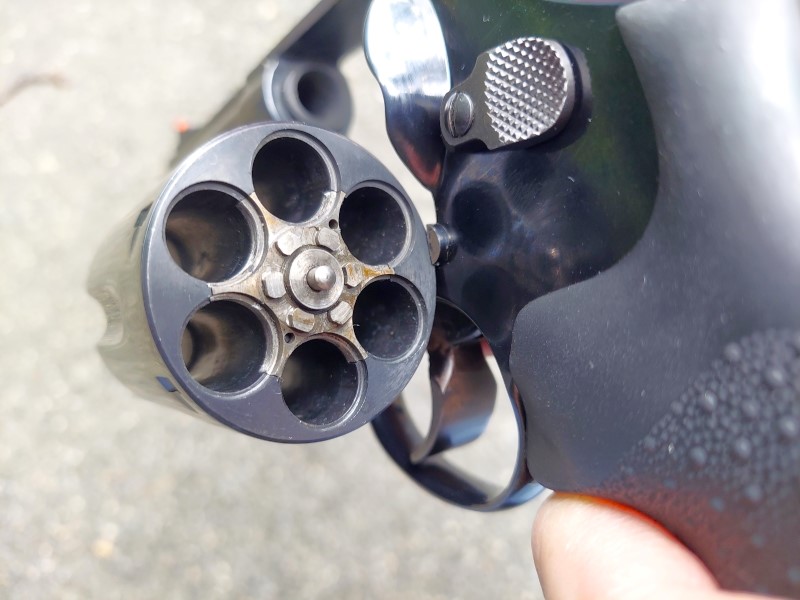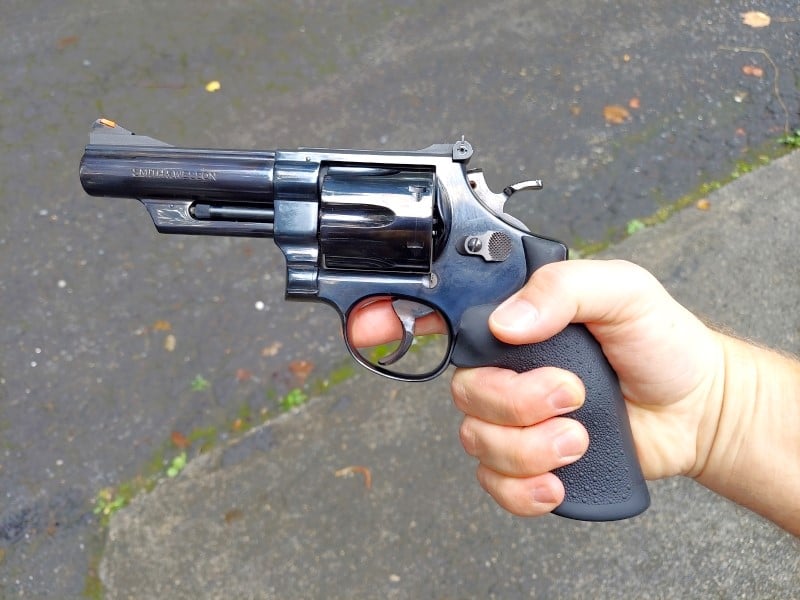Smith & Wesson’s Model 29 .44 Magnum was introduced in 1955 and later became famous when Clint Eastwood used it as Dirty Harry on the big screen. The gun remains in production to this day. Let’s take a closer look at the Model 29 and see what makes it tick.
The Infamous Model 29
After “Dirty Harry” premiered in 1971, many shooters who were fans of the movie also became instant fans of the Model 29. You might say that every Tom, Dick, and… Harry… wanted one.
You’ll remember the scene:
“I know what you’re thinking. Did he fire six shots, or only five? Well, to tell you the truth, in all this excitement, I’ve kinda lost track myself. But being this is a .44 Magnum, the most powerful handgun in the world, and would blow your head clean off, you’ve got to ask yourself one question: ‘Do I feel lucky?’ “Well, do ya, punk?'”
Shortly thereafter, when the miscreant surrenders to Dirty Harry, he just can’t resist asking, “Hey…I gots to know!” The suspense was killing him. It turns out that it was six rounds.
The Model 29 sold out in gun stores in short order, and it took Smith & Wesson a little while before they caught up with the demand. Even then, whenever the networks ran the “Dirty Harry” series on television, sales of the Model 29 shot up.
Since we’re delving into movie trivia here, I’ll run roughshod with it for a moment. The original movie script indicated a Model 29 with a four-inch barrel. However, the four-inch barrel didn’t quite have the massive presence that filmmakers were after, so they specified that a longer barrel was desired.
Smith & Wesson was only too happy to oblige, given that their revolver was about to be center stage; they figured it would help sales, but they might have had no idea just how much. For the movie posters, a Model 29 with an 8 3/8-inch barrel was used. The one for the actual movie filming was 6.5 inches long.
Enough about Hollywood, let’s take a look at the real Model 29 and see what we’re working with here.
Tech Specs
Smith & Wesson’s Model 29 weighs 43.9 inches with a four-inch barrel and has a length of 9.25 inches overall. With the six-inch barrel, it weighs 48.3 ounces and has a length of 12 inches. The height is 6.1 inches, and at a width of 1.7 inches, it’s a thick handgun.

The action is double action/single action. Standard grips are wooden. The frame and barrel are carbon steel. The front sight is a ramp with a red insert. The finish is black with standard bluing.
Characteristics
The pistol I reviewed had a four-inch barrel. Overall, it handled well, although it is a very heavy revolver. And it has to be, considering that it fires the .44 Magnum (which is no longer the world’s most powerful handgun).

This particular specimen was made a number of years ago. I have to say, the action was amazingly impeccable. When I swung the cylinder out and returned it, it was so buttery smooth that I was compelled to swing it out several more times, savoring the smoothness of the parts working together. You simply don’t find actions this smooth these days on revolvers.
Trigger
The double-action trigger was so obscenely smooth that it’s hard to even describe. I didn’t have a gauge to measure the pull, but the single-action pull was very light and as crisp as any trigger I’ve ever felt. This was pure, classic Smith & Wesson quality.
Is the Model 29 practical?
There’s little doubt that Dirty Harry’s Model 29 had a commanding stage presence. But was it practical for a police detective to carry on duty?
It’s a rather large, heavy handgun, and toting it would be a real job that would nearly qualify as a cardio workout nowadays. Plus, deploying the revolver in a hurry would be difficult. Not to mention the unwieldy handling characteristics of such a huge hand canon.
Back in the 1970s, revolvers were the main issue of police departments, so the issue of round count wouldn’t have been an issue yet at that time.

Other factors come into play as well. Overpenetration of the .44 Magnum round would be a real concern, considering the populated areas it would be deployed in. If we were talking about hunting in wild locales, that wouldn’t be an issue.
On top of that is the factor of recoil and how it hinders the rapid engagement of multiple targets and follow-up shots.
The full-power .44 Magnum just might not be the answer. And speaking of the .44 Magnum, let’s take a closer look at the ballistics involved.
The Cartridge — .44 Magnum
Elmer Keith is credited for being the principal inventor of the .44 Magnum round, having been loading hot .44 Special bullets for some time. Smith & Wesson listened to him and the .44 Magnum was born. The Model 29 was Smith & Wesson’s first .44 Magnum revolver. Incidentally, the .44 Special debuted in 1907, and featured more modest velocities than the Magnum round.
Typically, a 240-grain .44 Magnum bullet will reach about 1,230 feet per second from a four-inch barreled revolver with muzzle energy of around 806 foot pounds. A Remington 180-grain jacketed soft point round travels around 1,610 feet per second from a four-inch barrel.
The longer 6.5-inch barrel generates even more velocity and pounds because the longer barrel gives more time for gases to build. Muzzle velocity would be around 1,400 feet per second, with a muzzle energy of around 1,000 foot-pounds.
The .44 Magnum is one of the most versatile cartridges, in that it can be had in a variety of various bullet weights. Some of the more popular, various bullet weights are 180, 200, 225, 240, and 300 grains. And there are probably a few that I’m missing.

It has been used to hunt a very wide variety of game, including white-tailed deer, elk, moose, mountain lions, bear, and bison. Even elephants have been taken with the round. It will certainly defend against humanoid attacks, but there is some risk of overpenetration, depending upon the type of ammunition used.
A .44 Magnum round cannot be fired in a revolver chambered for .44 Special. However, a .44 Special round can be fired through a .44 Magnum chambered handgun. The .44 Special fires a heavy bullet, but at much more modest velocities, which means its recoil is softer and more pleasant than its Magnum brother.
The S&W Model 29 at the Range
We retired to the range with some 240-grain fodder for the Model 29. Rather than shooting for group size, we were ringing 10-inch metal gongs at 50 yards. At that range, it was not a tough task to consistently be on target. This revolver would likely hit silhouette-sized targets at well over 100 yards easily. The ultra-smooth trigger no doubt was a big factor in the accuracy.

Recoil was not terrible, but then the revolver’s weight was substantial, keeping the muzzle flip to a reasonable level. Add to that the fact that this revolver featured a ported barrel (from the factory). I’m not sure how effective the porting was in keeping recoil down, as I did not have a non-ported Model 29 to test it against. Suffice it to say, though, that it shot very nicely.
Parting Shots
The Model 29 is still in production to this day. For a firearm to be in constant production since the 1950s says quite a bit about it. And it’s still in relative demand, which at least partly owes to its “Dirty Harry” fame of so many years ago.
Is the fame due solely to the movie? I think not. It’s a sweet revolver that’s effective for what it is realistically meant to do. Which is performing in the hunting field, target shooting, self-defense, and looking cool. It does all of these functions fairly well, though as I mentioned, I won’t be carrying one with me for self-defense on my person.
Maybe Dirty Harry was right… you should check one out.


